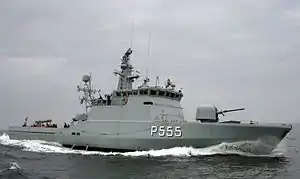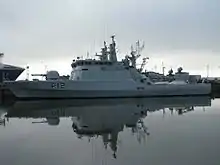Flyvefisken-class patrol vessel
The Flyvefisken-class patrol vessels ("Flying fish" in Danish) are warships of the Royal Danish Navy. The class is also known as the Standard Flex 300 or SF300 class. The five vessels sold to the Portuguese Navy are locally referred as Tejo class.
 P555 HDMS Støren | |
| Class overview | |
|---|---|
| Name: | Flyvefisken class |
| Operators: | |
| Subclasses: | Tejo class (Portugal) |
| Built: | 1985–1995 |
| In commission: | 1989– |
| Planned: | 17 |
| Completed: | 14 |
| Cancelled: | 3 |
| Active: | 9 |
| Retired: | 1 |
| Preserved: | 3 (for sale) |
| General characteristics [1] | |
| Type: | Patrol vessel |
| Displacement: |
|
| Length: | 54 m (177 ft 2 in) |
| Beam: | 9 m (29 ft 6 in) |
| Draught: | 2.5 m (8 ft 2 in) |
| Propulsion: |
|
| Speed: |
|
| Range: | 3,860 nmi (7,150 km) at 18 kn (33 km/h; 21 mph) |
| Complement: | 19-29 depending on role |
| Sensors and processing systems: | |
| Armament: |
|
.jpg.webp)

Containerised weapon systems
The Flyvefisken ships were constructed using an innovative modular design known as StanFlex: they have a standard hull in which containerised weapons or systems can be placed. This allows them to rapidly change roles, typically in 48 hours. This enables the ships to be configured to perform the following roles:
- Surveillance/pollution control
- Combat
- Mine countermeasures/minehunter (MCM)
- Minelayer
The containers measure 3.5 by 3 by 2.5 metres (11.5 ft × 9.8 ft × 8.2 ft). One container is situated on the foredeck; the other three go on the quarterdeck behind the superstructure and funnel. Furthermore the ships are built using the sandwich principle - a layer of fiberglass either side of a core of PVC cell foam. This forms the structure from keel to top of mast. This building method reduces maintenance costs - so much so that 20 years later the new Diana and -Holm class have been built using the same materials.[2]
Replaced three different vessels
The Flyvefisken class replaced three different vessels in the Danish Navy: Six torpedo boats of the Søløven class (1965–90), six coastal minesweepers of the Sund class (1955–99) and eight seaward defence craft of the Daphne-class Seaward Defence Craft (1961–91). It was possible because of the containerised systems and modern technology.
The replaced vessels used World War II (or World War I) tactics: The Søløven boats were light plywood boats propelled by three turboshafts, which attacked the enemy ships with torpedoes in 54-knot (100 km/h; 62 mph) hit-and-run attacks. The Flyvefisken class is not that fast, but their Harpoon missiles are sufficient for the task.
The Sund-class minesweepers were built of wood, bronze and other non-magnetic materials. They swept mine fields by trawling through the area with paravanes on tow separating magnetic and acoustic generators for the bottom mines, and chain cutters for the horned mines. The Flyvefisken class is a minehunter and locates the mines with side-scan sonar and neutralizes them one by one with a ROV.
The Daphne class attacked submarines by dropping depth charges to a preselected depth, while sailing past the submarine. The Flyvefisken class fights submarines with anti-submarine homing torpedoes.
Ships in class
A total of 14 ships were built in the class, in three series:
| # | Name | Laid down | Launched | Commissioned | Decommissioned | Int. Callsign | Role |
|---|---|---|---|---|---|---|---|
| Series 1 | |||||||
| P550 | Flyvefisken (Flying fish) | 15 August 1985 | 26 April 1986 | 19 December 1989 | Sold to Lithuania, March 2007 - LVS Žemaitis (P 11) | OVDA | MCM |
| P551 | Hajen (Shark) | February 1988 | 6 August 1989 | 19 August 1990 | Sold to Lithuania, March 2007 - LVS Dzūkas (P 12) | OVDB | MCM |
| P552 | Havkatten (Catfish) | August 1988 | 13 January 1990 | 1 November 1990 | 12 January 2012 - Sold to Lithuania, 23 November 2016 - LVS Sėlis (P 15) | OVDC | MCM |
| P553 | Laxen (Salmon) | March 1988 | 20 May 1990 | 12 March 1991 | 7 October 2010 | OVDD | MCM |
| P554 | Makrelen (Mackerel) | December 1988 | 8 January 1991 | 4 October 1991 | 7 October 2010 | OVDE | MCM |
| P555 | Støren (Sturgeon) | August 1989 | 1 September 1991 | 24 April 1992 | 7 October 2010 | OVBF | MCM |
| P556 | Sværdfisken (Swordfish) | - | 1 September 1991 | 1 February 1992 | 2 August 2006, scrapped | OVDG | MCM |
| Series 2 | |||||||
| P557 | Glenten (Kite) | - | 1992 | 1 February 1992 | 7 October 2010 Sold to Portugal, October 2014 - NRP Mondego (P 592) | OVDH | Combat |
| P558 | Gribben (Vulture) | - | 1992 | 1 July 1993 | 7 October 2010 Sold to Portugal, October 2014 - as spare parts hull | OVDI | Surveillance |
| P559 | Lommen (Loon) | - | 1993 | 21 January 1994 | Sold to Lithuania, March 2007 - LVS Aukštaitis (P 14) | OVDJ | Surveillance |
| P560 | Ravnen (Raven) | - | 1994 | 7 October 1994 | 7 October 2010 Sold to Portugal, October 2014 - NRP Douro (P 591) | OVDK | Combat |
| P561 | Skaden (European magpie) | - | 1994 | 10 April 1995 | 7 October 2010 Sold to Portugal, October 2014 - NRP Guadiana (P 593) | OVDL | Combat |
| P562 | Viben (Northern lapwing) | - | 1995 | 15 January 1996 | 7 October 2010 Sold to Portugal, October 2014 - NRP Tejo (P 590) | OVDM | Combat |
| Series 3 | |||||||
| P563 Y311 | Søløven (Sea lion) | - | 1995 | 27 May 1996 | - | OVDN | Surveillance Diving support from 2012 |
The difference between the series is mainly in the configuration of the propulsion system. Series 2 is not equipped with hydraulic propulsion, but instead has an additional auxiliary engine, and Series 3 has one further auxiliary engine.
References
- "Specifications: Flyvefisken Class (SF 300) Multi-Role Vessels - Naval Technology". www.naval-technology.com. Retrieved 2009-11-26.
- "Flyvefisken Class (SF 300) Multi-Role Vessels - Naval Technology". www.naval-technology.com. Retrieved 2009-11-26.
| Wikimedia Commons has media related to Flyvefisken-class. |